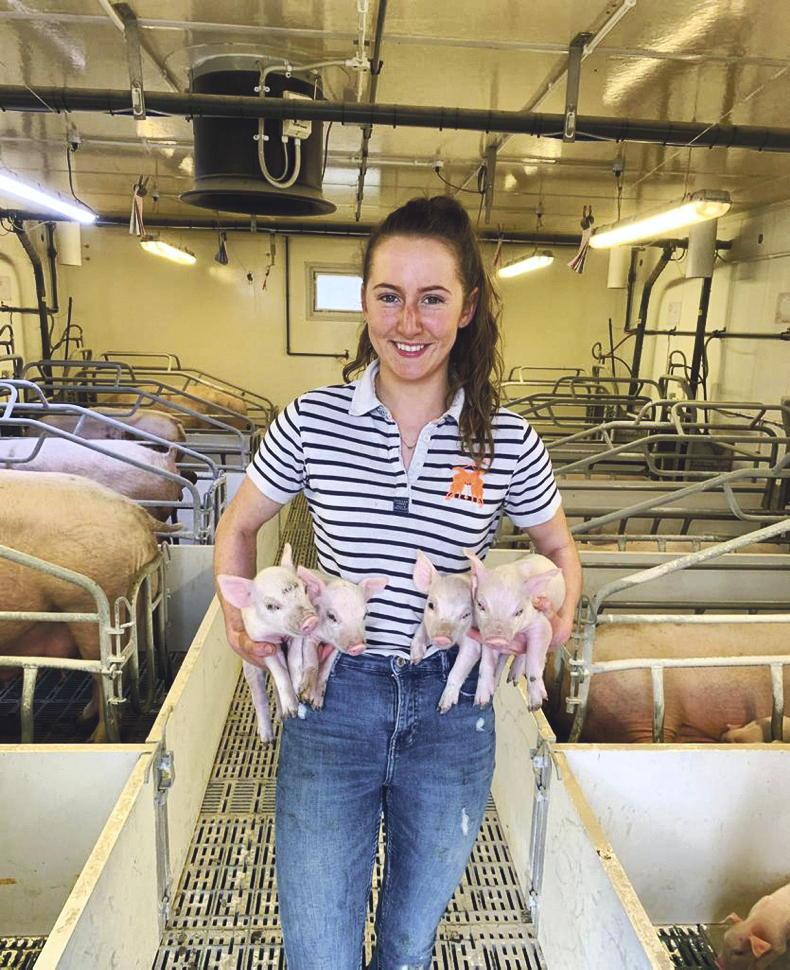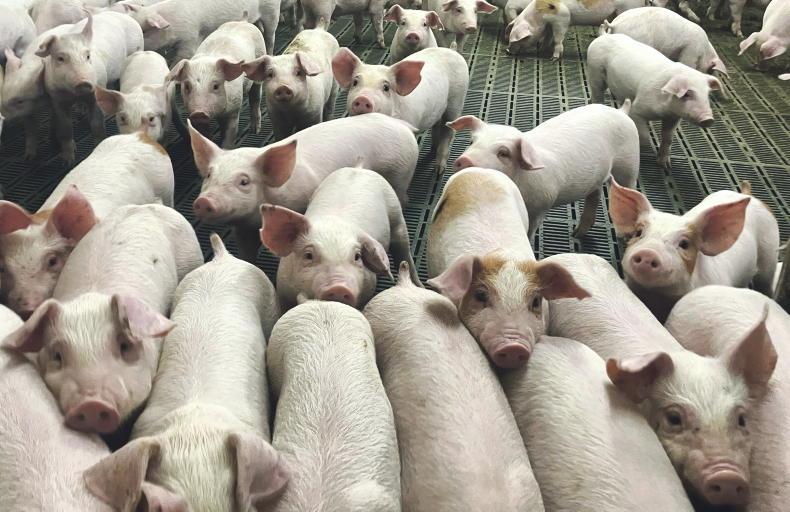Towards the end of 2020, the Telfords became aware of a sudden drop in performance.
“We noticed a real change in the pigs, they were just not thriving,” Keith explains. “It seemed to be affecting the pigs around five weeks post-weaning, with a lack of weight gain and loose dung. But the real problem was with the finishers. They were eating but not gaining, pale and sickly, and we were seeing up to 10% mortality. The problem just seemed to get worse and worse into the start of 2021.”
Their vet, Paul Spillane from Moss Vet performed up to a dozen post-mortems of affected pigs of all ages. The initial diagnosis was of ileitis, which was later confirmed by laboratory tests.
“Once we were sure what we were dealing with, I was able to work with the team in putting together both a treatment plan and a prevention plan for the Lawsonia infection,” explains Paul.
“The causes of scour in pigs can be quite tricky to diagnose, so it’s a good idea to get your vet involved early if you’re at all concerned.”
Ileitis is a gastrointestinal disease affecting growing pigs and caused by the bacteria Lawsonia intracellularis.
In Ireland, ileitis is usually seen in pigs from 10 to 12 weeks of age, often in the second-stage weaners.
While it may cause scour or loose faeces, the Lawsonia bacteria causes inflammation and thickens the gut wall, even in the absence of diarrhoea.
Unlike short-term bacterial gut infections, part of the ileum becomes permanently damaged, causing long-term reduction in food absorption. Consequently, feed conversion rates (FCR) and average daily weight gain (ADWG) are lower for the rest of the pig’s life.
The Telfords worked together with Paul and nutritionist, Ultan Keady, to tackle the problem. An initial course of in-feed medication helped to control the problem and performance began to stabilise.
Around four to six weeks later, he began to vaccinate against ileitis with Porcilis Lawsonia.
The vaccine has been proven to reduce diarrhoea, loss of daily weight gain, intestinal lesions, bacterial shedding and mortality caused by Lawsonia intracellularis infection and offers 21 weeks’ immunity to growing pigs. The Telfords administer the vaccine at around three weeks of age, mixed with another vaccine, Porcilis PCV M Hyo.
“The improvement was like the flick of a light switch,” adds Keith.
“We saw a total transformation throughout the unit, but in particular we saw mortality drop right back down to less than 1%.”
The farm had been using high levels of zinc oxide, even in the grower feed, but since tackling the ileitis problem it has been possible to remove it completely from the weaner diet and reduce levels right down in the creep and link.
Alongside other changes to feed and nutrition, the family plans to remove zinc completely in the coming months.
“We no longer have those narrow, uneven pigs and you can tell by looking that they’re doing well, and we’ve also seen the number of days to slaughter reduced. The results just speak for themselves,” Keith adds. “It’s all definitely working now.”

Clare Murray in the Telfords’ farrowing house.
EXCEPTIONAL PERFORMANCE
Clare Murray, who recently won Pig World’s Stockperson of the Year award, runs the farrowing houses on Telford’s farm and also has her own contract finisher house. She monitors production statistics closely and since tackling the ileitis outbreak, she has seen a huge improvement, with a weaning to sale FCR of 2.25 and weaning to sale ADWG of 880g and above. “It’s great to know that by giving those pigs a good start, they’re able to achieve their potential. By measuring what we’re doing we can see what’s working well,” Clare explains.
Ultan Keady, nutritionist at Cargill, is impressed. “When we started working with the Telford team in the second half of 2020, we could see that there was exceptional work ethic and attention to detail on the farm. This was evident in the sow performance. However, we noticed some issues in the growing herd, so a root and branch approach was implemented from weaning.
Once the nutrition and health (in this case ileitis) were tackled, we were able to get to work on reducing zinc and maintaining and improving weight gain. The unit is a completely different picture today. Credit to Derek, Keith, Arnold and the team.”
FLEXIBLE VACCINATION
Porcilis Lawsonia can be mixed with the Porcilis PCV M Hyo vaccine to provide protection against ileitis, porcine circovirus and Mycoplasma hyopneumoniae in a single injection. It can also be used at the same time as Porcilis PRRS, where this is necessary, through an intramuscular double injector.
MSD Animal Health also provides a range of vaccines for intradermal vaccination through the IDAL device, including Porcilis Lawsonia. It is now possible to vaccinate piglets against ileitis, porcine circovirus, Mycoplasma hyopneumoniae and PRRS at the same time. Always speak to your vet about vaccination regimes for your farm.
Further information is available from your veterinary practitioner or MSD Animal Health, Red Oak North, South County Business Park, Leopardstown, Dublin 18, Ireland. MSD Animal Health can be contacted at: 01-2970220 or emailed at: vet-support.ie@msd.com
Towards the end of 2020, the Telfords became aware of a sudden drop in performance.
“We noticed a real change in the pigs, they were just not thriving,” Keith explains. “It seemed to be affecting the pigs around five weeks post-weaning, with a lack of weight gain and loose dung. But the real problem was with the finishers. They were eating but not gaining, pale and sickly, and we were seeing up to 10% mortality. The problem just seemed to get worse and worse into the start of 2021.”
Their vet, Paul Spillane from Moss Vet performed up to a dozen post-mortems of affected pigs of all ages. The initial diagnosis was of ileitis, which was later confirmed by laboratory tests.
“Once we were sure what we were dealing with, I was able to work with the team in putting together both a treatment plan and a prevention plan for the Lawsonia infection,” explains Paul.
“The causes of scour in pigs can be quite tricky to diagnose, so it’s a good idea to get your vet involved early if you’re at all concerned.”
Ileitis is a gastrointestinal disease affecting growing pigs and caused by the bacteria Lawsonia intracellularis.
In Ireland, ileitis is usually seen in pigs from 10 to 12 weeks of age, often in the second-stage weaners.
While it may cause scour or loose faeces, the Lawsonia bacteria causes inflammation and thickens the gut wall, even in the absence of diarrhoea.
Unlike short-term bacterial gut infections, part of the ileum becomes permanently damaged, causing long-term reduction in food absorption. Consequently, feed conversion rates (FCR) and average daily weight gain (ADWG) are lower for the rest of the pig’s life.
The Telfords worked together with Paul and nutritionist, Ultan Keady, to tackle the problem. An initial course of in-feed medication helped to control the problem and performance began to stabilise.
Around four to six weeks later, he began to vaccinate against ileitis with Porcilis Lawsonia.
The vaccine has been proven to reduce diarrhoea, loss of daily weight gain, intestinal lesions, bacterial shedding and mortality caused by Lawsonia intracellularis infection and offers 21 weeks’ immunity to growing pigs. The Telfords administer the vaccine at around three weeks of age, mixed with another vaccine, Porcilis PCV M Hyo.
“The improvement was like the flick of a light switch,” adds Keith.
“We saw a total transformation throughout the unit, but in particular we saw mortality drop right back down to less than 1%.”
The farm had been using high levels of zinc oxide, even in the grower feed, but since tackling the ileitis problem it has been possible to remove it completely from the weaner diet and reduce levels right down in the creep and link.
Alongside other changes to feed and nutrition, the family plans to remove zinc completely in the coming months.
“We no longer have those narrow, uneven pigs and you can tell by looking that they’re doing well, and we’ve also seen the number of days to slaughter reduced. The results just speak for themselves,” Keith adds. “It’s all definitely working now.”

Clare Murray in the Telfords’ farrowing house.
EXCEPTIONAL PERFORMANCE
Clare Murray, who recently won Pig World’s Stockperson of the Year award, runs the farrowing houses on Telford’s farm and also has her own contract finisher house. She monitors production statistics closely and since tackling the ileitis outbreak, she has seen a huge improvement, with a weaning to sale FCR of 2.25 and weaning to sale ADWG of 880g and above. “It’s great to know that by giving those pigs a good start, they’re able to achieve their potential. By measuring what we’re doing we can see what’s working well,” Clare explains.
Ultan Keady, nutritionist at Cargill, is impressed. “When we started working with the Telford team in the second half of 2020, we could see that there was exceptional work ethic and attention to detail on the farm. This was evident in the sow performance. However, we noticed some issues in the growing herd, so a root and branch approach was implemented from weaning.
Once the nutrition and health (in this case ileitis) were tackled, we were able to get to work on reducing zinc and maintaining and improving weight gain. The unit is a completely different picture today. Credit to Derek, Keith, Arnold and the team.”
FLEXIBLE VACCINATION
Porcilis Lawsonia can be mixed with the Porcilis PCV M Hyo vaccine to provide protection against ileitis, porcine circovirus and Mycoplasma hyopneumoniae in a single injection. It can also be used at the same time as Porcilis PRRS, where this is necessary, through an intramuscular double injector.
MSD Animal Health also provides a range of vaccines for intradermal vaccination through the IDAL device, including Porcilis Lawsonia. It is now possible to vaccinate piglets against ileitis, porcine circovirus, Mycoplasma hyopneumoniae and PRRS at the same time. Always speak to your vet about vaccination regimes for your farm.
Further information is available from your veterinary practitioner or MSD Animal Health, Red Oak North, South County Business Park, Leopardstown, Dublin 18, Ireland. MSD Animal Health can be contacted at: 01-2970220 or emailed at: vet-support.ie@msd.com







 This is a subscriber-only article
This is a subscriber-only article





